Philippine National Railways
.svg.png) | |
| Industry | Rail transport |
|---|---|
| Founded |
1892 (as Ferrocarril de Manila-Dagupan) 1964 (as Philippine National Railways) |
| Headquarters | Manila, Philippines |
Area served |
Metro Manila Calabarzon Bicol Region |
Key people |
Ret. P/Dir. Gen. Roberto T. Lastimoso, PNP, Chairman Junn B. Magno, General Manager |
| Services |
Current: Commuter rail Suspended[a]: Inter-city rail Freight services |
| Owner | Government of the Philippines under DOTr |
| Website | http://www.pnr.gov.ph/ |
The Philippine National Railways (PNR) (Filipino: Pambansang Daambakal ng Pilipinas) is a state-owned railway company in the Philippines, operating a single line of track on Luzon. As of 2016, it operates one commuter rail service in Metro Manila and local services between Sipocot, Naga City and Legazpi City in Bicol Region.[1]
PNR began operations on November 24, 1892 as the Ferrocarril de Manila-Dagupan, during the Spanish colonial period, and later becoming the Manila Railroad Company (MRR) during the American colonial period. It became the Philippine National Railways on June 20, 1964 by virtue of Republic Act No. 4156. The PNR is an agency of the Department of Transportation.
PNR used to operate over 1,100 km (684 mi) of route from La Union to the Bicol Region.[2] However, neglect reduced PNR's service. Persistent problems with informal settlers in the 1990s contributed further to PNR's decline. In 2006, Typhoons Milenyo and Reming caused severe damage to the network, resulting in the suspension of the Manila-Bicol services. In 2007 the Philippine government initiated a rehabilitation project aiming to remove informal settlers from the PNR right of way, revitalize commuter services in Metro Manila, and restore the Manila-Bicol route as well as lost services in Northern Luzon. In July 2009, PNR unveiled a new corporate identity and inaugurated new rolling stock. Long-distance Bicol services resumed in June 2011, but were suspended again in October 2012, leaving only local service between Naga and Sipocot.[3] Local service between Naga and Legazpi resumed in October 2015.[4]
History

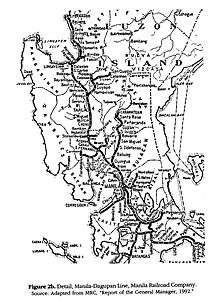

On June 25, 1875, under a royal decree issued by King Alfonso XII of Spain, the required Inspector of Public Works of the Philippine Islands was requested to submit a railway system plan for Luzon. The plan, which was submitted five months later by Don Eduardo Lopez Navarro, was entitled Memoria Sobre el Plan General de Ferrocarriles en la Isla de Luzón, and was promptly approved. A concession for the construction of a railway line from Manila to Dagupan was granted to Don Edmundo Sykes of the Ferrocarril de Manila–Dagupan (Manila–Dagupan Railway), later to become the Manila Railway Company, Ltd. of London, on June 1, 1887.[5][6]
The Ferrocarril de Manila–Dagupan, which constitutes much of the North Main Line today, began construction in July 31, 1887 with the laying of the cornerstone for Tutuban station, and the 195-kilometer (121 mi) line opened on November 24, 1892. Expansion of the Philippine railway network would not begin until the American colonial period, when on December 8, 1902, the Philippine Commission passed legislation authorizing the construction of another railway line, which would later form the South Main Line. Additional legislation was passed until 1909 authorizing further railway construction and the use of government bonds to finance them, and by 1916, 792.5 kilometers (492.4 mi) of track had been built by the company, which had reorganized itself as the Manila Railroad Company of New Jersey (MRR).[7] Apart from the North and South Main Lines, other lines branching out of these two main lines were built, like the lines to Rosales and San Quintin, Pangasinan; San Jose and Cabanatuan, Nueva Ecija; Dau, Carmen, Floridablanca and Arayat, all in Pampanga province, as well as inside the US Air Base Fort Stotsenburg which became Clark Air Base; Antipolo, Taytay, and Montalban, a spur line to Nielsen Field in what is now Ayala Avenue in the Makati Financial District from Culi Culi (now Pasay Road) Station, all in Rizal province; Cavite City and the nearby US Air Base of Sangley Point as well as Noveleta and Naic, both in Cavite province; Canlubang, Santa Cruz and Pagsanjan all in Laguna province; Batangas City and Bauan both in Batangas province, as well as a line connecting San Pablo City in Laguna to Luta (later Malvar) in Batangas province (This used to be part of Main Line South until a shorter cut-off line connecting Los Banos on the Santa-Cruz/Pangsanjan line to San Pablo was opened; Port Ragay in the Bicol province of Camarines Sur; as well as till Tabaco from Legaspi, Albay.
Similar to other railroads at the time, the Manila Railroad Company suffered from financial difficulties during World War I, and on February 4, 1916, the Philippine Assembly passed Act No. 2574, authorizing the Governor-General to negotiate for the nationalization of the MRR's assets. The MRR was eventually nationalized in January 1917, with the Philippine government paying ₱8 million to the company's owners and assuming ₱53.9 million in outstanding debt. Consequently, the MRR's management shifted from British to American hands, and in 1923, José Paez became the first Filipino general manager.[7]
During the 1920s, the MRR embarked on a general program of improvements as a result of operating surpluses accrued over much of the decade. The ₱30 million program allowed for the extension of railway service on the North Main Line from Dagupan to San Fernando in La Union, the extension of the South Main Line to Legazpi in Albay, and the construction of several spur lines. The last rail connecting Manila to Bicol was laid on November 17, 1937 and regular direct service between Manila and Legazpi was inaugurated in May 8, 1938, and by 1941, the MRR operated 1,140.5 kilometers (708.7 mi) of track.[7]
On December 14, 1941, at the start of World War II, the MRR was put under U.S. military control, and on December 30, the MRR management was ordered to allow U.S. military forces to destroy network infrastructure, resulting in very extensive damage to train facilities and right of way. Coupled with further damage during the Japanese occupation of the Philippines, where the Imperial Japanese Army operated services on a very limited basis using whatever could be salvaged, and further fighting in the Allied liberation of the Philippines by the combined American and Filipino forces a few years later, damages to railroad property amounted to around ₱30 million.[7] By the end of the war, only 452 kilometers (281 mi) were operational,[5] largely as a result of the United States Army and the Philippine Commonwealth Army was performing temporary repairs on railroad infrastructure for military purposes. MRR property was later returned to the Philippine government on February 1, 1946.[7]
Following the war, the MRR was able to restore limited services, using surplus military equipment and payments made by the United States Army and the Philippine Commonwealth Army for use of railway facilities in the Philippines Campaign. By July 1, 1947, funded by a ₱20 million rehabilitation allocation set aside by the Philippine government, around 75% of the entire railway network prior to 1941 was rehabilitated. By 1951, with the MRR receiving ₱3 million in war reparations funds, 941.9 kilometers (585.3 mi) of track, representing 82.5% of the total railway network prior to 1941, was in operation.[7] Later in the 1950s, the MRR fleet of locomotives was converted from steam to diesel engines, and the company was given a new charter under Republic Act No. 4156, becoming the modern-day Philippine National Railways.

Natural calamities such as the 1973 and 1975 floods disrupted services and forced the closure of several parts of the main lines. On July 23, 1979, President Ferdinand Marcos issued Executive Order No. 546, which designated the Philippine National Railways as an attached agency of the Department of Transportation and Communications.[5] In 1988, during the administration of Corazon Aquino, the North Main Line was closed, with trains unable to reach various provinces in the country. Even the South Rail was also closed due to typhoons and floods, and the eruption of Mayon Volcano in 1993, in which ash flows and lava destroyed the rail line and its facilities. However, jeeps, buses and taxis were popular, and many people are swayed from the present service until 2009. When Fidel V. Ramos succeeded Corazon Aquino, he decided to rehabilitate the South Main Line from Tutuban to Legaspi, and appointed Jose B. Dado as the new PNR general manager.
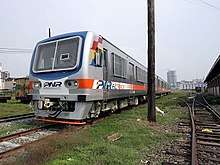
.png)
The administration of Gloria Macapagal-Arroyo actively pursued the rehabilitation of the Philippine National Railways through various investments and projects designed to revive Philippine rail transport,[5][8][9] despite the numerous problems involved. Total reconstruction of rail bridges and tracks, including replacement of the current 35-kilogram (77-pound) track with newer 50-kilogram (110-pound) tracks[9] and the refurbishing of stations, were part of the rehabilitation and expansion process. The first phase, converting all the lines of the Manila metropolitan area, were completed in 2009.[9] On July 14, 2009, Gloria Macapagal-Arroyo presided over the launch of the new diesel multiple-units of the Philippine National Railways. As part of its new image, a new brand name, PNR Filtrack was added and a new PNR logo was unveiled until the succeeding administration decided to revert to the original logo.[10]
The San Cristobal bridge in Calamba, Laguna was rebuilt in May, 2011. The Bicol Express train service was inaugurated on June 29, with a maiden voyage between Manila and Naga City plus a return trip back to the terminus on July 1. This inaugural trip was marred by the collapse of the embankment at Malaguico, Sipocot. It was discovered before the train passed through and was repaired. The restored Bicol Express intercity service was offered on a daily basis, running mostly during night time.
The current administration under Rodrigo Duterte is working towards the rehabilitation of the PNR, the establishment of a railway from New Clark City to Metro Manila, the North-South Commuter Railway,[11] the reconstruction of the current South Commuter line, and the reestablishment of long-haul services to the south. Rehabilitation of tracks and stations commenced.
After nearly 20 years, PNR reopened the Caloocan-Dela Rosa line, on August 1, 2018.[12][13] This would be followed by a steady expansion and reintroduction of rail services, reaching to Malabon City, which has not seen rail activity for nearly 20 years. A plan to reactivate the Carmona line was bared as well,[14] and the revival of cargo rail from Port Area, Manila to Laguna is now being planned.[15][16]
Operations and services
The PNR currently operates in the Manila metropolitan area and the provinces of Laguna, Quezon, Camarines Sur (Naga City) and Albay. In the past, the PNR also used to serve the provinces of Bulacan, Pampanga, Tarlac, Nueva Ecija, Pangasinan and La Union on the North Main Line, and Batangas, Naic and Cavite City as well as Carmona, Cavite, Pagsanjan, Laguna, Rodriguez (formerly Montalban), Taytay and Antipolo in the province of Rizal, on the South Main Line.
Summary of services
| Service | Terminus | Status | |
|---|---|---|---|
| Metro South Commuter (MSC) | Tutuban | Alabang | Operational |
| Tutuban | Mamatid | Operational | |
| Tutuban | Calamba | Operational | |
| Shuttle Service (SS) | Tutuban | Caloocan | Operational |
| Caloocan | FTI | Operational | |
| Acacia (Malabon) | FTI | Planned | |
| Acacia (Malabon) | Tutuban | Planned | |
| Dela Rosa | Carmona | Planned | |
| Tutuban | Sucat | Discontinued | |
| Santa Mesa | Sucat | Discontinued | |
| Alabang | Calamba | Planned | |
| Premiere Train | Tutuban | Mamatid | Discontinued |
| Bicol Commuter (BCT) | Tagkawayan | Naga | Suspended |
| Sipocot | Naga | Operational | |
| Naga | Legazpi | Operational | |
| Bicol Express (BEx) | Tutuban | Naga | Suspended |
| Tutuban | Ligao | Suspended | |
| Mayon Limited Deluxe (MLD) | Tutuban | Ligao | Discontinued; replaced by ILE |
| Mayon Limited Ordinary (MLO) | Tutuban | Ligao | Discontinued; replaced by ILE |
| Isarog Limited Express (ILE) | Tutuban | Naga | Suspended |
Metro Commuter Line
The Metro Commuter (also known by the remaining active service MSC or Metro South Commuter),[17] which was formerly called Commuter Express (also Commex), serves as the commuter rail service for the Manila metropolitan area, extending as far south as Calamba City, Laguna. The PNR uses GE locomotives such as 900 Class, 2500 Class, and 5000 Class hauling Commex passenger cars as well as newly procured 18 (3 car trains, 6 sets) Hyundai Rotem DMUs and KiHa 52 for this service. 203 series EMUs are now also used for Metro Commuter runs.
MSC service using the new DMUs, KiHa 52, KiHa 350 and 203 series EMUs is currently offered between Tutuban and Alabang in Muntinlupa City. Currently, MSC makes 42 return services, 21 in each direction.[18]
Shuttle Service
The Shuttle Service is a commuter rail service initially introduced on January 27, 2014. This service used Hyundai Rotem DMUs and JR KiHa 52. There were 2 routes of the Shuttle Service, where trains stop at all stations along the routes: Tutuban – Sucat and Santa Mesa – Sucat. This train service ended May 23, 2014 to conduct maintenance on the rolling stocks and due to the consecutive three weeks of delays and cancellations of this train service.
Formerly, plans for a third route plying Alabang – Calamba was to be introduced sometime in 2017. This service will use the reliveried two-car Kiha 350, however, the promised third line was moved to that of the 10th Avenue - Dela Rosa route beginning August 1, 2018, as part of the renovation of the line and the return of train services to Caloocan City. The revived train service now terminates at Sangandaan, the original Caloocan since September 10, extending through FTI. [19] Plans to expand the line to Acacia in Malabon City is now underway.
A new shuttle line leading to the once-abandoned Carmona branch line is planned for reopening in 2019, and will originate from the Dela Rosa station in Makati City.[20]
Premiere Train
The Premiere Train service is a commuter rail service introduced on March 3, 2014 and uses JR KiHa 59 "Kogane" trainset. The Premiere Train originates from Tutuban Terminal and stops at Blumentritt, España, Santa Mesa, Buendia, EDSA, Sucat, Alabang, San Pedro, Biñan and Santa Rosa stations. Fares cost ₱ 60.00 to ₱ 90.00
This train service was supposed to be removed on May 23, 2014 because they will use modified 203 series EMUs that will stop at all stations between Tutuban Terminal and Santa Rosa Station to cater more passengers. It was replaced by the 203 series on June 25, 2014.
Bicol Commuter
The Bicol Commuter service is a commuter rail service in the Bicol Region, between stations in Tagkawayan, Quezon, and Legazpi, Albay, with Naga City in Camarines Sur acting as a central terminus, the center of transportation. The service was launched on September 16, 2009, in time for the feast of Our Lady of Peñafrancia in Naga City.[10] The trains made seven trips a day, alternating between Tagkawayan, Sipocot, Naga City and Legazpi. All services used KiHa 52 series in revised blue livery.
After further reductions, only service between Naga and Sipocot was operating as of December 2013.[21] Service resumed between Naga and Legazpi in October 2015 with one train a day.[22]
Bicol Express

The PNR has been working for some years on restoring this intercity service without success. As of September 2013, operations to the Bicol Region have been suspended.[23] This is primarily because of typhoon damage to bridges. The PNR hoped to reopen the Bicol Express Service by about September 2014.[24] Due to the damages brought by the Typhoon Rammasun, known in the Philippines as Bagyong Glenda, it was announced that the Bicol Express' resumption of services would be further delayed until October and November 2014. Since then resumption of service has been repeatedly announced and then cancelled, most recently in late 2016.[25]
The trip designator is Train T-611 for the southbound (MA-NG) and Train T-612 for the northbound (NG-MA).
Bicol Express started operations between Manila and Aloneros around 1919 with a separate train between Pamplona and Tabaco and between Port Ragay and Legazpi since 1933. The first Bicol Express from Manila to Legazpi ran on January 31, 1938.
Mayon Limited
In March 2012, another train service, the resurrected Mayon Limited, ran between Tutuban and Ligao. The train ran as Mayon DeLuxe on Monday, Wednesday and Friday from Tutuban as train T-713 with three air-conditioned carriages with reclining seats. The train returned on Tuesday, Thursday and Sunday as train T-714 from Ligao. On Tuesdays, Thursdays and Sundays the train ran as Ordinary train (T-815) with non-reclining seats and cooling by fan. The departure as train T-816 was every Monday, Wednesday and Friday. The train did not run on Saturdays.[26] The trains meet at Gumaca.[27] As of September 2013, all operations to the Bicol Region, including the Mayon Limited, have been suspended.[23]
The original Mayon Limited service decades ago was hauled alternatively by French Alstom locomotives and General Electric locomotives, and ran northward from Legazpi up the steep gradient leading to Camalig in the foothills of the Mayon Volcano with another locomotive pushing from the rear. The service was assigned as (Train T-577) and was considered then as the fastest and the most modern train of the Philippine National Railways operating on the South Main Line.
Defunct services
Intercity services
Although the Southern Luzon Intercity Services has occasionally operated in recent years, some of its branches are defunct such as the Batangas City Intercity railways. Efforts are underway to restore both services. Northern line intercity that once serviced by Amianan Express and the Dagupan Express has permanently ceased operation.
Lucena Express
The Lucena Express was first operated between Malvar and Aloneros, Guinayangan, and later between Manila and Lucena, stopping at Blumentritt (San Lazaro), Santa Mesa, Paco, San Pedro, Biñan, Santa Rosa, Calamba, Los Baños, College, Masaya, San Pablo, Tiaong, Taguan, Candelaria, Lutucan and Sariaya stations.
Prestige and Peñafrancia Express
The old Prestige service used Japanese-built, self-propelled coaches and was the only train not to be hauled by General Electric locomotives. It was frequently the first of the three express trains to arrive. With priority over all other trains on its route, and stopping only at Daraga, Ligao, Naga, Lucena, and Paco. it normally arrived at the Tutuban railway station, Manila's central, making it a popular service with businessmen. The 48-seater air-conditioned coaches of the Prestige were somewhat narrower and lower than those built in Madras, which also contributed to the faster run.
During the management of Pete Nicomedes Prado from 1986 till 1991 as GM, the PNR inaugurated the Penafrancia Express between Manila and Naga City. Train formations consisted of a GE Series 900 locomotive hauling a baggage car and several passenger coaches, both aircon and economy. The airconditioned coaches had sleepers, de luxe coaches, and dining lounge coaches. Also used on Penafrancia Express trains were self-propelled commuter motor coaches from Japan, also using aircon as well as nonaircon coaches. Initially they were non-stop between Paco Station in Manila and Naga City itself, save for when the Penafrancia Express trains headed in opposite directions had to cross each other along the route in Quezon province. Later on, additional stops started getting added, mostly in the Bicol province of Camarines Sur with the train stopping in towns like Ragay, Sipocot, and Libmanan.
The Penafrancia Express trains also had airline style features, like piped in music, snacks, caterers, and stewardesses.
Express services
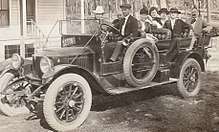
The PNR also operated several express services. Some of these services were discontinued for financial reasons. The first express service for Luzon was the Baguio Express, which operated from Manila via Dagupan and San Fabian, Pangasinan to Camp One on Kennon Road, where the motor vehicles, namely the Stanley and De Dion steamers, of the Benguet Auto Line transported passengers proceeding to Baguio. Overnight services were provided by the Baguio Night Express with Baguio Friday Night during Fridays and Baguio Night Special during special seasons. Another express service was the Ilocos Express, which has been operating since March 15, 1930 until the closure of the line in the late 1980s. The services includes a dining car with catering provided by the Manila Hotel. Another variant of the service was the Baguio-Ilocos Express. Following the modernization program of the Manila Railway Company in 1955, the Ilocos Express featured a 7A class "De Luxe" coach until 1979, when the lack of operable air-conditioned coaches caused a switch to a "Tourist"-class coach. The company also operated the Paniqui Express in the 1930s, but that was eclipsed by the Ilocos Express.
The fastest train operated by the PNR on the North Main Line was the Ilocos Special (Train 26), started in 1973, this diesel multiple-unit (DMU) train took four hours to run the 195 kilometres between Manila and Dagupan City. The PNR also introduced the Amianan Day Express (Train 74) in February 1974 and the Amianan Night Express (Train 72), the last train to depart Manila for any destination on both lines. The Amianan Night Express ran faster than its day counterpart, the Amianan Day Express, making the 260-kilometre run to San Fernando City, La Union in five hours.
Non-passenger services
The PNR used to offer freight services, using General Electric U15C 900-series locomotives bought by the company in 1974. It is currently planned for a revival leading to the Manila North Harbor.[15][16]
There was also a limited mobile hospital service.
Stations
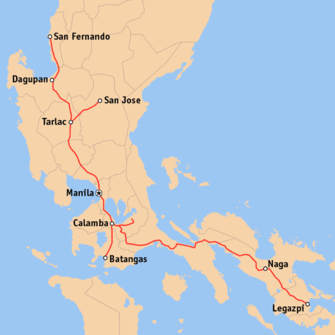
The Philippine National Railways used to operate two different rail lines, namely the North Main Line and the South Main Line, along with the three spur lines, which served various parts of Luzon with its 138 (once) active stations.
Station layout
All PNR stations were and are presently at-grade, with most stations using a side platform layout. Most have only basic amenities, platforms and ticket booths. Rehabilitated stations along the Metro Manila line have been fitted with ramps for passengers using wheelchairs. Several stations have extended platforms, having an upper platform catering to DMU services, and a lower platform for regular locomotive-hauled services.
As of August 2017, most of the stations are being extended and equipped with platform-length roofing, better ticketing office, and restrooms.
Future railway systems under the PNR, such as that of the new Northrail line, proposes elevated stations and platforms similar to the LRT-1 and 2, and the MRT-3 and 7 in select sections.
Plans
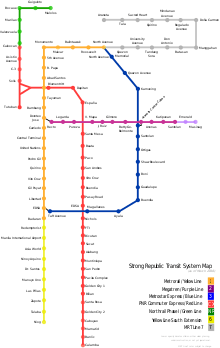
Plans to rehabilitate and expand the railway network have been made by various administrations. South Korea and the People's Republic of China have offered to help rehabilitate the Philippine railway system, the former assisting with the rehabilitation and modernization of the South Main Line[8] and the latter helping to finance, build, and operate a rationalized North Main Line service as well as helping to rehabilitate and modernize the South Main Line.
PNR North 1 and 2 (Northrail Project/North-South Commuter Railway and Malolos-Clark Railway)
The Northrail project involved the upgrading of the existing single track to an elevated dual-track system, converting the rail gauge from narrow gauge to standard gauge, and linking Manila to Malolos City in Bulacan and further on to Angeles City, Clark Special Economic Zone and the Clark International Airport. This project was estimated to cost around US$500 million, with China offering to provide some US$400 million in concessionary financing.[28] Preparatory construction began in early November 2006.[29] Due to delays in the construction work, it was soon being renegotiated with the Chinese government. Construction temporarily continued in January 2009 with the support of the North Luzon Railways Corporation. Again, the project was cancelled in March 2011, due to a series of delays, work stoppages, a controversy and anomalies with the foreign contractor.[30] The railway project was contracted out by the Arroyo administration in 2003 to China National Machinery and Equipment Corporation (CNMEC) for an original cost of $421 million. In 2009, CNMEC increased the contract price to $593 million, with the government agreeing to shoulder the difference. The government loaned $400 million from China’s Exim Bank to fund the project, with the balance sourced from the Development Bank of the Philippines. In 2011, the Aquino administration scrapped the project on lingering legal issues and corruption allegations. The Philippine Supreme Court handed down in March 2012 a decision giving a lower court the go-signal to hear the case calling for the annulment of the allegedly overpriced contract. Instead of settling the entire US$184 million due in 2012, the Department of Finance will pay Export-Import Bank of China 4 equal payments of $46 million starting September 2012.[31] National Economic and Development Authority (NEDA) Director-General Arsenio Balisacan said the 80-kilometer Northrail project would resume within the term of President Benigno Aquino III.[31]
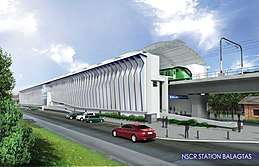
The Department of Transportation and Communications has examined reviving the project by commissioning a feasibility study by CPCS Transcom Ltd. of Canada. Part of the study examined having a Malolos-Tutuban-Calamba-Los Baños Commuter Line.[32][33]
The final name for the Northrail project was announced by Department of Transportation Secretary Arthur Tugade on June 25, 2017 with a ceremony in which the first 5 stations were given their location markers. It aims to cut travel time between the two cities from two hours to 55 minutes, allowing easier travel for commuters from Bulacan and Pampanga who travel daily to Manila for work or school. The 106-kilometer railway line will run from Tutuban Station in Manila to Clark Freeport Zone in Pampanga, passing through Clark International Airport. There will be 13 trainsets with 8 coaches per set, each capable of achieving a maximum speed of 120 km/h (75 mph). The project will cost ₱255 billion (US$5.1 billion) with financial assistance from Japan. Construction is expected to start in the last quarter of 2017 and to be completed by 2021.[34][35]
Pre-construction work such as clearing of the right of way have been started as of January 2018.
PNR East West Line
The PNR East West line, also known as formerly MRT Line 9, is a proposed rapid transit line in Metro Manila in the Philippines, generally running in an east-west direction along the Radial Road 7 and a portion of the Radial Road 8.
The line serves 11 stations on 9.4 kilometers (5.8 mi) of line. The rails are mostly elevated and erected either over or along the roads covered, with sections below ground. The western terminus of the line is the Quiapo station infont of Quiapo Church, while the eastern terminus of the line is the Diliman station along Commonwealth Avenue in Barangay Old Capitol Site, Quezon City. The rail line serves the cities that Radial Road 7 (Commonwealth Avenue, Elliptical Road, Quezon Avenue, España Boulevard and Quezon Boulevard) passes through: Manila and Quezon City.[36]
As part of the infrastructure program by president Rodrigo Duterte, East-West Rail was proposed by the East-West Rail Transit Corp., a consortium between A. Brown Company Inc. and Private Equity Investment and Development Corp. It involves the financing, design, construction, and maintenance of a mostly-elevated 9.4-kilometer railway line from Diliman in Quezon City to Quiapo in Manila.[37]
The project is currently awaiting approval from NEDA to further proceed. It is also currently tackling right-of-way issues, such as that of the España Boulevard alignment.
Freight revival
Within February 2016, the PNR's planned freight comeback will start with a planned signing of a MOA between the railway and rail freight operator MRAIL (a Meralco subsidiary firm) for the rehabilitation of the rail lines to North Harbor and to restart the freight services starting 2017, which will also help reduce traffic congestion and truck use in the NCR.[38] If completed, MRAIL will jointly operate the freight service with the PNR, which will end a long absence of railway freight services in the country. This will be the 2nd time the PNR will be partnered with ICTSI.[39]
A statement made by MRail Inc., a subsidiary of Metro Pacific Investments Corp., said that all discusions regarding the PNR freight service revival from the Port of Manila to Laguna Gateway Inland Container Terminal is continued with the appointment of a new board at the Philippine National Railways.[40]
Representatives of PNR and ICTSI conducted an inspection of the ROW where the former railtracks leading to the North Harbor existed, signalling the start of the action to realize the cargo rail revival.[15]
PNR South Commuter reconstruction (NSRP - South Line)
As part of the DuterteNomics ("Build-Build-Build") infrastructure program by Rodrigo Duterte, the Metro Commuter Line will be reconstructed as an electrified standard-gauge full double-track line, and will be extended to serve Los Baños. On September 12, 2017, the National Economic and Development Authority approved the construction of the newer line, as part of the longer Long-haul Railway that will connect to Legazpi and Matnog, and Batangas City.[41][42] Funding for the project, which costs ₱131 billion, is provided by the Japan International Cooperation Agency, and is expected to serve 300,000 passengers a day at its initial year of operation.[41]
PNR South Long Haul Project (Southrail Project) and Calamba-Batangas City Railway
Along with the reconstruction of the Metro South Commuter Line, the railway line to Bicol (to Legazpi and Matnog) will be reconstructed, and the revival of the line from Calamba to Batangas City. The National Economic and Development Authority approved the projects in September 12, 2017, but, no clear timeline of construction has been set. The construction of the Manila-Bicol and Calamba-Batangas City lines will be funded by the government of China, and those lines will feature new standard-gauge lines, to be initially operating as single-track lines and eventually, become double-track lines. [43]
Mindanao Railway
President Rodrigo Duterte expressed his support for the establishment of a railway system in the entire island of Mindanao which may be in operation after his term ends. The railway system to be built in Mindanao will have about 2,000 kilometers of trackage, and considered one of Rodrigo Duterte's primary infrastructure projects. The first phase, which is 105 km, will start construction in the third quarter of 2018 and is expected to be completed by 2022.[44]
Partial reactivation of North Main Line (Metro North Commuter)
Planned as early as 2006 during the term of Gloria Macapagal-Arroyo, the northern Manila-Dagupan line of PNR was to be reactivated, comprising initially of new stations at Solis, C3 5th Avenue, Asistio and relocation and reconstruction of Caloocan station at par with the Southrail stations. The rest beyond Caloocan Station would be the new elevated Northrail. They were completed but for some reason were never put to use. They became largely abandoned during Aquino's term and lay unused, with the railroad tracks used only to travel to the depot station in Caloocan, resulting in the degradation of the railtracks that were reconstructed.
The predicament was worsened with the historical Caloocan station being partially demolished for NLEX Segment 10.1.
DOTr first envisioned to reuse the revived at-grade stations and the original right of way for a shuttle line ending at Dela Rosa station in Makati. The North Main Line has been modified to co-exist with the elevated high-speed NorthRail that would first reach Malolos and eventually lead to Clark, as opposed to the previous arrangement where the entire at-grade North Main Line will be scrapped. Beginning March 2018, restoration works were done to clear and ensure the tracks are still in condition.[45] However, the line will be temporarily a single-track line in light of the NLEX Segment 10.1 construction. Other restoration works such as ballast tamping were done, including the installation of track switches, with the line restarting operations on August 1, 2018. The reactivated runs initially from Caloocan to Makati and uses a single special fare matrix of PHP 12.00 for ordinary, and PHP 15.00 for air-conditioned. This was later upgraded to reach FTI in Taguig, with now a distance-based fare matrix. A Caloocan to Tutuban and vice-versa shuttle service also exists, using the original right-of-way once used for the Dagupan line. Originally terminating at Asistio station while the historical Caloocan station was still being prepared for activation,[46] the station now terminates at its originally intended station since September 10.
DOTr and PNR are also working on reviving and reactivating rail services in areas already prepared for NorthRail, such as Malabon and possibly Valenzuela and beyond. First proposed and planned last September 2018[47], the extension to Gov. Pascual Avenue and the re-establishment of Acacia railway station in Malabon is now underway, with new rail ties and narrow gauge rail tracks being restored.[48]
The line is provisional and services will be potentially interrupted when the elevated railtracks are to be constructed, likely after the construction of NLEX Segment 10.1. The reconstructed lines are also targeted for freight use as well.
Rolling stock
Four types of rolling stock run on PNR's lines: the locomotives, the Commex express cars, baggage cars and DRC railcars.[49] All services are operated by GE Universal Series locomotives (PNR 900 Class and PNR 2500 Class) and Hyundai Rotem DMUs. There are 14 locomotives, 18 (3 car trains, 6 sets total) Diesel Multiple Units, 2 baggage cars and 8 DRC railcars currently operating.[49] Surplus sleeper coaches from Japan Railways were acquired by PNR, and were delivered on November 2010. More used rolling stock from Japan Railways were as well acquired by PNR, and arrived in 2011 which included some 203 series EMU, Kiha 350, KiHa 52 and Kogane Train (Kiha 59).[50] The EMUs were then modified for non-electrified railways use by adding an electric generator set at the front car behind the driver's cab.
In addition, 6 Indonesian-manufactured DMUs and the railway's first 3 diesel hydraulic locomotives with 5 passenger coaches each, all made by the national rail manufacturer Industri Kereta Api, will join the fleet in 2019-2020.[51] These are the first new equipment to be accquired by the PNR in many years, and the DHLs also serve as the first new locomotives to join the railways since 1996.
An experimental hybrid electric trainset (DOST Hybrid Electric Train) locally built by the Department of Science and Technology's Metals Industry Research and Development Center is now under evaluation and modifications for potential use in revenue runs, and the possible birth of a local train manufacturing industry akin to Indonesia's.[52]
| Rolling stock | General Electric Universal Series locomotives | Hyundai Rotem Diesel multiple units | Baggage cars | DRC railcars |
|---|---|---|---|---|
| In operation | 14 | 18 (6 sets) | 2 | 8 |
| Support equipment | Rail Mounted Crane | Rail Mounted Crane | Rail Mounted Crane | - |
| Support equipment capacity | 0.5 tonnes | 30 tonnes | 10 tonnes | - |
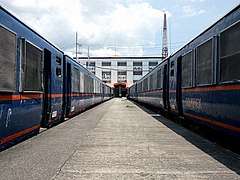

 Class 900 diesel locomotive hauling modified 203 series EMUs arriving at EDSA station
Class 900 diesel locomotive hauling modified 203 series EMUs arriving at EDSA station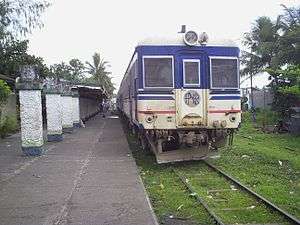 A KiHa 52 at Ligao Station
A KiHa 52 at Ligao Station
See also
Notes
- ^ Inter-city and freight services have been suspended since 2016. The Manila-Clark Railway will be the first intercity service since the discontinuation of the Bicol Express in 2016. Construction of the line shall commence by late 2017. There are also plans to revitalize to freight service. See Freight revival for more information.
References
- ↑ "Fares & Tickets". Retrieved 2016-10-31.
- ↑ "Sad saga of PNR". Inquirer.net. May 13, 2014. Retrieved 2014-07-29.
- ↑ "Bicol Express revival hinges on safety issues". 29 December 2013. Retrieved 2016-10-31.
- ↑ "Train: Naga to Legazpi open! Soon again Bicol Express?". 9 September 2015. Retrieved 2016-10-31.
- 1 2 3 4 "Brief history of PNR". Philippine National Railways (February 27, 2009). Archived from the original on February 27, 2009. Retrieved November 4, 2011.
- ↑ "Manila Railroad Company". National Register of Historic Sites & Structures in the Philippines. National Historical Commission of the Philippines. Retrieved 6 September 2013.
- 1 2 3 4 5 6 "Chapter I: Present Conditions". Report of Survey of the Manila Railroad Company and the Preliminary Survey of Railroads for Mindanao (Report). Chicago: De Leuw, Cather & Company. 1951. pp. 1–12.
- 1 2 Maragay, Fel V. (December 15, 2005). "Rehab of busy railway". Manila Standard Today. Archived from the original on July 21, 2006. Retrieved May 2, 2010.
- 1 2 3 Olchondra, Riza T. (April 22, 2007). "PNR rail rehabilitation to start September". Philippine Daily Inquirer. Manila. Archived from the original on February 21, 2013. Retrieved April 28, 2010.
The Philippine National Railways (PNR) will start repairing and improving its North and South railways by September, PNR General Manager Jose Ma. Sarasola II said Friday.
- 1 2 Escandor Jr., Juan; Caudilla, Pons (September 18, 2009). "Bicol train chugs to a halt in test run". Philippine Daily Inquirer. Manila. Archived from the original on September 22, 2009. Retrieved April 29, 2010.
The spirit was willing, but the diesel-fed old engines were not.
- ↑ "17 stations of Manila-Clark Railway announced". Rappler. Retrieved 2018-08-01.
- ↑ "20 YEARS AFTER: DOTr sees 10,000 passengers taking PNR's reopened Caloocan-Dela Rosa line". GMA News Online. Retrieved 2018-08-01.
- ↑ News, ABS-CBN. "After 20 years, PNR's Caloocan to Makati line to reopen". ABS-CBN News. Retrieved 2018-08-01.
- ↑ "Department of Transportation - Philippines". www.facebook.com. Retrieved 2018-10-12.
- 1 2 3 https://www.facebook.com/DOTrPH/posts/1215191695286631
- 1 2 Yee, Jovic. "PNR to offer freight service soon". Retrieved 2018-10-12.
- ↑ "Metro Commuter". Philippine National Railways. Archived from the original on March 17, 2011. Retrieved June 8, 2014.
- ↑ http://www.pnr.gov.ph/northbound-southbound-timetable
- ↑ https://www.facebook.com/pnrofficialpage/photos/a.247872075258165/2080678781977476/
- ↑ https://www.facebook.com/DOTrPH/posts/1186365421502592
- ↑ "Bicol Express revival hinges on safety issues". 29 December 2013. Retrieved 2016-10-31.
- ↑ "Train: Naga to Legazpi open! Soon again Bicol Express?". 9 September 2015. Retrieved 2016-10-31.
- 1 2 "Trains & Schedules". Official Website. Philippine National Railways. Archived from the original on August 20, 2013. Retrieved September 6, 2013.
Manila - Bicol trips are currently suspended. Please bear with us.
- ↑ "PNR to resume Bicol Express in Sept". GMA News Online. May 9, 2014. Retrieved 2014-07-29.
- ↑ "Bicol Express operations cancelled". Manila Bulletin. November 19, 2016. Retrieved 2017-01-04.
- ↑ "Mayon Limited resumes Bicol run". Philippine National Railways Press Release. Manila. Archived from the original on March 24, 2012. Retrieved March 19, 2012.
- ↑ "Mayon Limited". Archived from the original on March 17, 2012. Retrieved March 19, 2012.
- ↑ "RP, China break ground for Manila-Ilocos railway". Malaya. April 6, 2004. Archived from the original on May 9, 2010.
- ↑ "De Castro bats for hiring of squatters for NorthRail project". Philippine Daily Inquirer. Makati City. November 6, 2006.
- ↑ "U.P. study finds North Rail contract illegal, disadvantageous to government". The PCIJ Blog. September 9, 2005. Retrieved 2014-07-29.
- 1 2 http://www.rappler.com/business/industries/208-infrastructure/66861-aquino-admin-revives-$400m-northrail-project
- ↑ <http://www.abs-cbnnews.com/business/07/22/13/dotc-eyes-elevated-railway-malolos-los-banos
- ↑ "Archived copy". Archived from the original on January 2, 2014. Retrieved January 1, 2014.
- ↑ 17 stations of Manila-Clark Railway revealed Rappler. Retrieved 2017-06-25.
- ↑ DOTr leads marking of Manila-Clark railway’s 5 future stations Philippine Daily Inquirer. Retrieved 2017-06-25.
- ↑ Megawide's proposed East-West Railway to cost $1 billion Rappler. Retrieved 2018-01-18.
- ↑ PNR East-West Railway Project Details Public Private Partnership Center. Retrieved 2018-01-18.
- ↑ http://www.untvradio.com/pnr-gagamitin-sa-pagde-deliver-ng-mga-kargamento-mabigat-na-trapiko-at-port-congestion-maaaring-mabawasan/
- ↑ http://www.autoindustriya.com/auto-industry-news/report-cargo-trains-to-be-revived-to-reduce-truck-traffic.html
- ↑ Camus, Miguel R. "MVP group, ICTSI to push P10-B railway plan". Retrieved 2017-07-20.
- 1 2 Dela Paz, Chrissie (September 13, 2017). "NEDA Board approves Manila subway, longest railway". Rappler. Retrieved September 15, 2017.
- ↑ Leyco, Chino S. (September 13, 2017). "NEDA Board approves big infra projects". Manila Bulletin. Retrieved September 15, 2017.
- ↑ Dela Paz, Chrisee (September 13, 2017). "NEDA Board approves Metro Manila Subway". Rappler. Retrieved September 14, 2017.
- ↑ "Build Build Build Presentation" (PDF). Build Build Build. 20 May 2017. Retrieved 14 July 2017.
- ↑ https://www.facebook.com/DOTrPH/posts/1073115239494278
- ↑ https://www.facebook.com/DOTrPH/posts/1171751846297283
- ↑ https://www.facebook.com/DOTrPH/posts/1196688110470323
- ↑ https://www.facebook.com/pnrofficialpage/posts/2119205864791434
- 1 2 "PNR Company Profile". Philippine National Railways. Archived from the original on August 11, 2009. Retrieved April 28, 2010.
- ↑ 日本の中古電車に熱視線 9月に引退した通勤車両、フィリピンで第二の人生 [Commuter trains retired in September to live a second life in the Philippines]. Sankei News (in Japanese). Japan: The Sankei Shimbun & Sankei Digital. November 26, 2011. Archived from the original on April 14, 2012. Retrieved April 16, 2012.
- ↑ http://newsinfo.inquirer.net/995374/pnr-buys-seven-more-trains-worth-p2-37-b-from-indonesia
- ↑ http://newsinfo.inquirer.net/956794/dost-offers-pnr-use-of-hybrid-train-made-by-ph-scientists
Further reading
- Uranza, Rogelio. (2002). The Role of Traffic Engineering and Management in Metro Manila. Workshop paper presented in the Regional Workshop: Transport Planning, Demand Management and Air Quality, February 2002, Manila, Philippines. Asian Development Bank (ADB).
- World Bank (May 23, 2001). "Project Appraisal Document for the Metro Manila Urban Transport Integration Project" (PDF). World Bank.
- Japan International Cooperation Agency Official Page "Revitalization of Main Line South Project(1989)"
External links
| Wikimedia Commons has media related to Philippine National Railways. |
- Philippine National Railways (official website)
- Official Facebook page of Philippine National Railways
- Facebook page of Philippine Railways
- Twitter page of Philippine Railways
- Facebook for Philippine Railway Historical Society